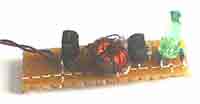Photo. This is the test circuit -the basic driver is only two transistors, two resistors, the circuit was evaluated using a white LED, but when it was time to button it up and archive it, I replaced the expensive white LED with a cheap green one.
Othere LED Driver Circuits on this site:
White LED drive from 1.5V
White LED inductorless drive from 1.5V and 3V.
Fast precision LED driver
White LED Stroboscope With Constant Duty Cycle and Constant Current Drive
When Dave and I were kicking around ideas for the best arrangement of components for white led flashlight, Dave suggested putting the voltage converter in place of the second cell in a two cell flashlight, and substitute an LED assembly for the incandescent lamp. “Yeah, I that would be ideal…” was my hesitant response, though I didn’t see how this would be possible. It took someone like Dave, who didn’t’ know it was impossible, to suggest doing it. Eventually a topology emerged that can actual run a 3.5 volt LED when it and the driver in series with a 1.5 volt flashlight cell. Well kind of, anyway. The trick was to put one additional component, a diode that is actually part of the driver, in parallel with the LED. Read on.
I was already using energy stored in an inductor that is part of a blocking oscillator to boost the voltage available for an LED (see the schematic below).
While this provided the necessary voltage boost, it required that the blocking oscillator be powered from both terminals of the battery. It seemed that some re-arrangement of the parts might result in a practical topology that would allow current built up in the inductor to be dumped through the LED. The circuit below emerged.
For more detal: Series Connected Voltage Boost Circuit for a Battery Operated LED Lantern using microcontroller

